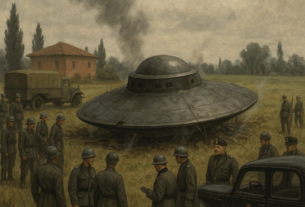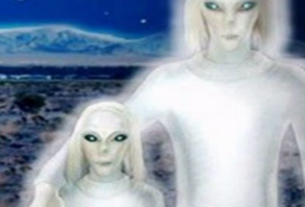On May 11, 1950, at around 7:30 p.m., Evelyn Trent, a farmer’s wife in her late 30s, was tending to her chores on her family’s farm near Sheridan, Oregon—about 13 miles southwest of McMinnville in the Willamette Valley—when she spotted an unusual object in the sky. While feeding the chickens and rabbits behind the farmhouse, she looked up and saw a metallic, disc-shaped object, described as resembling a “parachute canopy without strings, silver-bright mixed with bronze.” The object, estimated to be tens of meters in diameter, hovered silently to the northeast, moving slowly toward her from that direction. Startled, Evelyn ran to the house, shouting for her husband, Paul Trent, a 43-year-old farmer, to grab their camera. After a brief scramble—Paul thought the camera was in the car, but Evelyn found it in the house—they rushed back outside with their Universal Roamer folding Kodak, loaded with black-and-white film. Paul managed to snap two photographs of the object before it tilted, accelerated rapidly, and disappeared westward into the evening mist, producing no sound, smoke, or visible propulsion.
The Trents’ farm, located between McMinnville and Sheridan, was a quiet, rural property, and the couple were known as unassuming, hardworking people with no history of seeking attention. They initially feared the object might be a secret military experiment, a concern heightened by the Cold War climate and recent UFO reports, like Kenneth Arnold’s 1947 “flying saucer” sighting. Paul didn’t develop the film immediately, waiting until the roll was used up with family photos for Mother’s Day. On June 7, 1950, he showed the developed photos to his banker, Frank Wortmann, who displayed them in his McMinnville bank window. The images caught the eye of Bill Powell, a reporter for the McMinnville Telephone-Register, which published them on June 8, 1950, under the headline “At Long Last—Authentic Photographs Of Flying Saucer[?]” The story exploded, picked up by the International News Service, The Oregonian on June 10, and Life magazine on June 26, 1950, becoming a national sensation. The Trents appeared on radio and TV shows, including “We the People” in New York, but the media frenzy led to the temporary loss of their negatives, which Life magazine later claimed to have misplaced.

The photos depict a metallic, disc-shaped object with a flat base and a slight dome, hovering against a cloudy sky with power lines and a barn in the foreground. They gained credibility due to the Trents’ sincerity and lack of profit motive—Evelyn died in 1997 and Paul in 1998, both insisting until the end that their sighting was genuine. The U.S. Air Force and FBI investigated, finding no evidence of tampering, and in 1967, the Condon Committee, a U.S. Air Force-funded UFO study at the University of Colorado led by physicist Edward U. Condon, analyzed the negatives, which had resurfaced by then. Investigator William K. Hartmann concluded, “This is one of the few UFO reports in which all factors investigated, geometric, psychological, and physical, appear to be consistent with the assertion that an extraordinary flying object, silvery, metallic, disk-shaped, tens of meters in diameter, and evidently artificial, flew within sight of two witnesses.” Hartmann’s photometric analysis supported the object’s distance and size, aligning with the Trents’ account.
Skeptics, however, argue the photos are a hoax, suggesting the object could be a truck side-view mirror or a model suspended from wires, a theory bolstered by the object’s proximity to power lines in the images. The Condon report, while acknowledging the photos’ authenticity, didn’t rule out a hoax, and some analysts note the Trents’ delay in developing the film as suspicious. Yet, the couple’s lack of financial gain—never selling the photos—and their consistent story challenge this narrative. Ufologists like Bruce Maccabee, who spoke at McMinnville’s first UFO Festival in 2000, argue the photos remain among the best evidence of a physical UFO, citing their clarity and the witnesses’ credibility.
The sighting wasn’t isolated. Evelyn told The Oregonian in 1997 that she’d seen similar objects three times before at the Oregon Coast, though no one believed her then. A 2000 McMenamins newsletter revealed a local woman’s claim that dozens saw the same object earlier that day, though it went unreported, suggesting a broader event. Oregon’s UFO history includes a 1949 sighting by American Airlines pilots over the Cascades, describing a similar disc. The Trents’ photos, however, thrust McMinnville into the spotlight, earning it the nickname “Saucerville.” The town embraced this legacy, hosting its first UFO Festival in 1999 at McMenamins Hotel Oregon, a tradition continuing into its 25th year in 2025, with events like parades, costume contests, and talks by experts like Luis Elizondo.

The McMinnville UFO sighting remains divisive. Believers see it as proof of extraterrestrial visitation, while skeptics point to potential fabrication. The photos’ resistance to definitive debunking or confirmation keeps the debate alive, mirroring broader UFO mysteries like Roswell. For McMinnville, the sighting is a cultural touchstone, celebrated annually as a quirky piece of history that asks: what did Evelyn and Paul Trent really see that evening in 1950?



